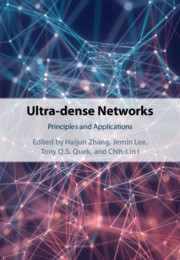Book contents
- Frontmatter
- Contents
- List of Contributors
- Part I Overview
- Part II Physical Layer Design
- Part III Resource Allocation and Network Management
- 9 Delay and Traffic Matching in Ultra-dense Networks
- 10 Traffic Offloading in Software Defined Ultra-dense Networks
- 11 Resource Allocation in Ultra-dense Networks
- 12 Wireless Edge Caching in Ultra-dense Networks
- 13 User Association in Ultra-dense Networks
- 14 UAV-Based Ultra-dense Networks
- 15 Generalized Low-Rank Optimization for Ultra-dense Fog-RANs
- Part IV Field Trials and Tests
- Index
14 - UAV-Based Ultra-dense Networks
from Part III - Resource Allocation and Network Management
Published online by Cambridge University Press: 12 October 2020
- Frontmatter
- Contents
- List of Contributors
- Part I Overview
- Part II Physical Layer Design
- Part III Resource Allocation and Network Management
- 9 Delay and Traffic Matching in Ultra-dense Networks
- 10 Traffic Offloading in Software Defined Ultra-dense Networks
- 11 Resource Allocation in Ultra-dense Networks
- 12 Wireless Edge Caching in Ultra-dense Networks
- 13 User Association in Ultra-dense Networks
- 14 UAV-Based Ultra-dense Networks
- 15 Generalized Low-Rank Optimization for Ultra-dense Fog-RANs
- Part IV Field Trials and Tests
- Index
Summary
Recently, with the development and popularization of unmanned aerial vehicles (UAVs), researches on UAVs have also been attracted increasing attention in wireless communications. By fully exploiting their potentials, leveraging UAVs to assist UDNs can greatly improve the system performance. The probability of having line-of-sight transmissions is higher than the probability in the terrestrial transmissions. Moreover, their attitudes can be freely adjusted. This chapter presents a vision of UAV based UDNs to exploit the potential merits of UAVs in UDNs. The channel characteristics are first discussed. Followed that, the representative scenarios where aerial UAVs are introduced to enhance terrestrial UDNs are investigated in detail, i.e., UAV-enabled BSs, UAV-enabled relays, and UAV-enabled energy transfer. UAV based UDNs also face many challenges, such as the limited spectrum resource and on-board energy. From the spectrum sharing perspective, this chapter also discusses the robust spectrum sharing optimization between UAV communications and terrestrial communications, where the scenarios with abnormal behaviors and uncertain/incomplete information are considered.
- Type
- Chapter
- Information
- Ultra-dense NetworksPrinciples and Applications, pp. 259 - 276Publisher: Cambridge University PressPrint publication year: 2020

